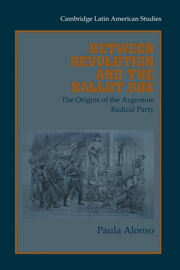Book contents
- Frontmatter
- Contents
- Acknowledgments
- List of Abbreviations
- List of Tables and Figures
- Introduction
- 1 The Political Arena
- 2 Mounting an Opposition
- 3 The Short-Lived Unión Cívica
- 4 The Radicals in Action: Part I
- 5 The Radicals in Action: Part II
- 6 The Decline of the Radical Party
- Conclusion
- Appendix 1 A Chronology of Political Parties and Factions, 1862–1910
- Appendix 2 Details of the Members of the National Committee of the UCR in 1892
- Appendix 3 Property Values in Buenos Aires, 1890–1898
- Bibliography
- Index
3 - The Short-Lived Unión Cívica
Published online by Cambridge University Press: 05 August 2011
- Frontmatter
- Contents
- Acknowledgments
- List of Abbreviations
- List of Tables and Figures
- Introduction
- 1 The Political Arena
- 2 Mounting an Opposition
- 3 The Short-Lived Unión Cívica
- 4 The Radicals in Action: Part I
- 5 The Radicals in Action: Part II
- 6 The Decline of the Radical Party
- Conclusion
- Appendix 1 A Chronology of Political Parties and Factions, 1862–1910
- Appendix 2 Details of the Members of the National Committee of the UCR in 1892
- Appendix 3 Property Values in Buenos Aires, 1890–1898
- Bibliography
- Index
Summary
The revolution of July 1890 and Juárez Celman's resignation initiated a period of uncertainty in Argentine politics. By August 1890, a decade of unchallenged domination by the PAN had ended; the political scene became fragmented and the set of rules which had governed politics in the preceding four years no longer applied. Historians have tended to oversimplify the political panorama of the post-Juárez Celman days. It has been erroneously assumed that the restoration of Roca's authority within the country immediately followed Juárez Celman's departure and that the emergence of the Unión Cívica Radical (UCR) was, therefore, a reaction against an all-powerful PAN. This interpretation has led to misunderstandings about the circumstance in which the UCR emerged, and about the nature of the party, its aims, and methods.
An alternative explanation of the events that took place between Juárez Celman's resignation (August 1890) and the election of Luis Sáenz Peña (April 1892) is offered in this chapter. The first section is devoted to the difficulties faced by the members of the Unión Cívica (UC) in their attempts to organize a political party during the months after Juárez Celman's departure. Originally organized as a temporary coalition, as a smokescreen for the planing of the revolution of 1890, the party had no solid foundations. Its internal conflicts, the framented political scene after Juárez Celman's downfall, and the uncertainty of the new situation made party organization a difficult task.
- Type
- Chapter
- Information
- Between Revolution and the Ballot BoxThe Origins of the Argentine Radical Party in the 1890s, pp. 69 - 93Publisher: Cambridge University PressPrint publication year: 2000

